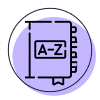
In natural language processing, a tokeniser is a tool used to break up text into discrete units called tokens. A token can be a word, punctuation, number, symbol or other meaningful unit in the text. The purpose of the tokeniser is to prepare the text for machine learning analysis and modelling.
There are different types of tokenisers, including rule-based and machine learning-based tokenisers. Rule-based tokenisers use predefined patterns to divide text into tokens, while machine learning-based tokenisers use language models to identify patterns and structures in the text and divide it into tokens.
Tokenisers are an important tool in natural language processing, as proper representation of input data is essential for training accurate machine learning models.
Artificial Intelligence (AI) derives from a series of models or branches that can be used in different areas of people's lives, as well as in different areas of [...]
Read More »To know how semantic technology works, the first thing you need to know is that it is responsible for helping artificial intelligence systems [...]
Read More »Intelligent Process Automation in companies has changed in the world very rapidly in recent years. The COVID-19, the interr [...]
Read More »In today's oversaturated information market, it is becoming increasingly difficult to retain users. For companies, competition is increasingly [...]
Read More »